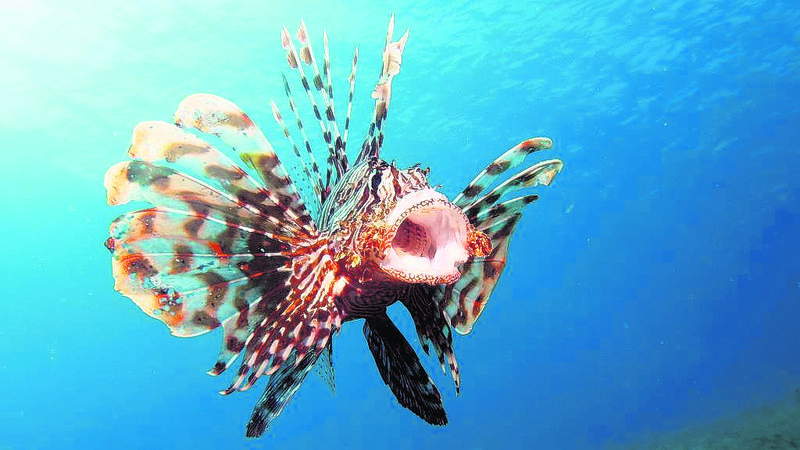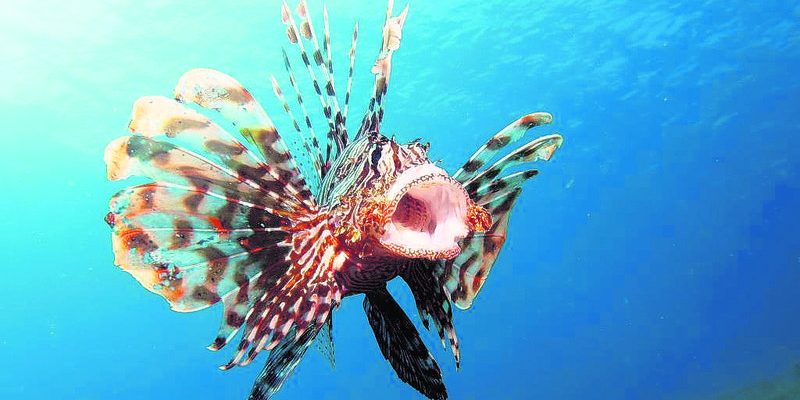
You might have seen those striking fish with long, flowing fins that resemble a lion’s mane. Lionfish are not just a pretty sight; they’re one of the ocean’s most fascinating—and sometimes controversial—inhabitants. With their vibrant colors and unique appearance, these fish can easily catch anyone’s eye. But there’s more to them than just good looks. They’re also a vital part of their ecosystem, and their presence tells us a lot about marine health.
Imagine stepping into a bustling underwater world, where the lionfish glides gracefully between coral reefs. Despite their beauty, these fish are infamous for their venomous spines, which serve as a warning to predators. But don’t let this scare you away; understanding lionfish means appreciating the balance of ocean life. So, let’s dive deeper and explore everything from their habitat to their role in our oceans.
Physical Characteristics
Lionfish are easy to identify thanks to their striking appearance. These fish usually feature reddish-brown stripes that provide excellent camouflage against the coral reefs. Their long, fan-like pectoral fins give them a regal look, almost like they’re wearing a royal cape. On average, lionfish can grow up to 15 inches long, though some individuals may reach up to 18 inches. Their bodies are slim and elongated, making them agile swimmers.
The real kicker? It’s the lionfish’s spines. Each fin is armed with venomous spines, which can cause painful stings to humans and predators alike. The venom isn’t generally lethal to humans, but it can lead to intense pain, swelling, and, in some cases, an allergic reaction. So, if you decide to go snorkeling and encounter one, remember to admire from a safe distance!
Habitat and Distribution
These mesmerizing fish thrive in warm waters, mainly found in the Indo-Pacific region, including the Red Sea and the Great Barrier Reef. However, they’ve made headlines as invasive species in the Atlantic Ocean. How did this happen? In the 1980s, lionfish were introduced to Florida waters, likely through the aquarium trade, and have since spread rapidly. They now inhabit coastal waters from North Carolina to the Caribbean, causing significant ecological disruptions.
Lionfish prefer rocky and coral reefs, where they can easily hide and hunt their prey. They’re also comfortable in various environments, including lagoons and estuaries. This adaptability, coupled with their lack of natural predators in non-native habitats, allows lionfish to thrive and outcompete local species for food.
Diet and Hunting Behavior
Lionfish are carnivorous and primarily feed on small fish and crustaceans. They have a unique hunting strategy that sets them apart from other fish. Instead of chasing down their prey, they ambush them. Lionfish use their long fins to create a kind of net, helping to trap fish in close quarters. Once caught, they quickly swallow their meal whole, thanks to their expandable stomachs. This hunting technique not only makes them effective predators but also highlights their adaptability in various environments.
Interestingly, their diet poses a challenge in their non-native habitats. Lionfish have significantly affected the populations of small fish that are vital for the health of coral reefs. A single lionfish can consume a large number of small fish each week, which can lead to a decline in local fish communities. This is one of the reasons why scientists and conservationists are so concerned about their presence in the Atlantic.
Life Cycle and Reproduction
Understanding the life cycle of lionfish is essential for grasping their impact on marine ecosystems. Lionfish reach sexual maturity at around one year old. They’re prolific breeders, with females capable of producing up to 30,000 eggs every few days! These eggs are released into the water column and float away, where they hatch into larvae within 24 to 36 hours.
The larvae are planktonic and drift with ocean currents for several weeks before settling on the sea floor. This early life stage contributes to their rapid population growth—very few predators can consume lionfish larvae due to their small size. Because of this reproductive strategy, lionfish can quickly establish themselves in new areas, making their control challenging.
Ecological Impact
Lionfish have become notorious for their ecological impact in places where they are considered invasive. Their voracious appetite and rapid reproduction rate create a perfect storm for local fish populations. By consuming small fish that help maintain coral reefs, lionfish can severely disrupt the delicate balance of marine ecosystems. Healthy reefs depend on a variety of fish species to thrive, and lionfish are overpowering these local communities.
In addition to their dietary impact, lionfish also compete for habitat and resources with native species. This can lead to a decrease in local biodiversity, which is vital for healthy ocean ecosystems. Conservationists are working tirelessly to address the lionfish invasion, promoting awareness, and encouraging fishing efforts to control their populations and protect native species.
Conservation Efforts
As the situation becomes increasingly dire, various conservation measures are being put into action. Many regions are organizing lionfish derbies, where fishermen compete to catch the most lionfish in a designated timeframe. These events not only increase awareness about the issue but also help reduce the lionfish population in specific areas.
Education plays a crucial role in these conservation efforts. Many organizations are working to inform both the public and fishers about the lionfish problem. By promoting lionfish as a food source, they aim to create a market that incentivizes people to catch more of these fish. Yes, lionfish are delicious! Chef-driven initiatives encourage incorporating lionfish into cuisines, thereby turning a problem into a culinary opportunity.
Table: Quick Facts About Lionfish
| Scientific Name: | Pterois volitans |
| Size: | Up to 18 inches (45 cm) |
| Habitat: | Coral reefs, rocky areas, and estuaries |
| Diet: | Small fish and crustaceans |
| Speed: | Up to 2 mph (3.2 km/h) |
| Lifespan: | Up to 15 years in the wild |
Frequently Asked Questions
What do lionfish eat?
Lionfish primarily consume small fish and crustaceans. They are effective predators, using their unique hunting technique to ambush prey rather than chase it. This diet allows them to thrive in various marine environments, but it can be detrimental to local fish populations, especially in areas where they are invasive.
Are lionfish dangerous to humans?
While lionfish have venomous spines that can cause painful stings, they are not lethal to humans. The stings can lead to swelling, redness, and intense pain, but serious allergic reactions are relatively rare. It’s best to admire these beautiful creatures from a safe distance to avoid accidental encounters.
How did lionfish end up in the Atlantic Ocean?
Lionfish were accidentally introduced to the Atlantic Ocean in the 1980s, likely through the aquarium trade. They have since spread rapidly, largely due to their lack of natural predators in these new waters. Their rapid reproduction also contributes to the challenge of controlling their population.
What is being done to control lionfish populations?
Various conservation efforts are underway to manage lionfish populations. These include organized fishing derbies, public education campaigns, and culinary initiatives that promote lionfish as a viable food source. These strategies aim to raise awareness and create a market that incentivizes catching lionfish.
Can lionfish be eaten?
Yes, lionfish are considered a delicacy! Their white, flaky flesh is not only delicious but also safe to eat. Many chefs are now incorporating lionfish into their menus as a way to help control their populations and turn an ecological problem into a culinary opportunity.
How fast can lionfish swim?
Lionfish can swim at speeds of up to 2 miles per hour (3.2 km/h). While this may not seem very fast, their hunting techniques and the ability to integrate into environments like coral reefs make them effective predators in their habitat.
What is the lifespan of a lionfish?
In the wild, lionfish can live up to 15 years. Their longevity, combined with their rapid reproduction, contributes to their ability to establish and grow populations quickly, particularly in non-native habitats where they have few predators.
Are lionfish social or solitary?
Lionfish are generally solitary creatures. While they may be found in groups in some areas, they typically prefer to hunt and live alone. This solitary behavior helps them be more effective predators, as they do not have to compete for food with other lionfish.
What is the role of lionfish in their ecosystem?
Lionfish play an important role in the marine ecosystem as predators. They help control the populations of small fish and crustaceans, contributing to the balance of their native environments. However, in non-native habitats, their overpopulation leads to significant disruptions in local fish communities.
How can I help with lionfish conservation?
You can help with lionfish conservation by becoming informed about the issue, participating in local fishing derbies, and promoting lionfish as a menu item in restaurants or home cooking. Spreading awareness about the lionfish problem can create a community effort to help control their population and protect marine biodiversity.
Can lionfish live in freshwater?
No, lionfish are saltwater fish and cannot survive in freshwater. Their physiology is adapted to oceanic conditions, including saline environments, which are essential for their health and reproduction.
What adaptations help lionfish survive in their environment?
Lionfish have several adaptations that aid their survival. Their venomous spines deter potential predators, while their vibrant coloration provides camouflage against coral and rocks. Additionally, their ambush-style hunting technique allows them to effectively capture prey without expending too much energy.
What are the signs of a lionfish sting?
Signs of a lionfish sting include intense pain, swelling, and redness at the site of the sting. In some cases, people may experience nausea or difficulty breathing if they have an allergic reaction. It’s important to seek medical attention if you experience severe symptoms or if the sting appears to be worsening.

